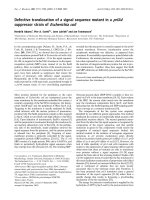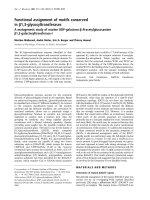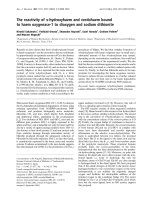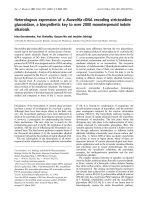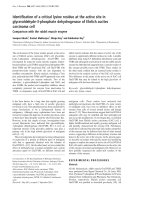Báo cáo y học: "Successful outcome of a pregnancy in a woman with advanced cirrhosis due to hepatitis B surface antigenemia, delta super-infection and hepatitis C co-infection: a case report" pdf
Bạn đang xem bản rút gọn của tài liệu. Xem và tải ngay bản đầy đủ của tài liệu tại đây (251.3 KB, 3 trang )
BioMed Central
Page 1 of 3
(page number not for citation purposes)
Journal of Medical Case Reports
Open Access
Case report
Successful outcome of a pregnancy in a woman with advanced
cirrhosis due to hepatitis B surface antigenemia, delta
super-infection and hepatitis C co-infection: a case report
Amna Subhan*, Shahab Abid and Wasim Jafri
Address: Department of Medicine, Aga Khan University Hospital, Karachi, Pakistan
Email: Amna Subhan* - ; Shahab Abid - ; Wasim Jafri -
* Corresponding author
Abstract
Pregnancy in women with advanced liver disease is rare. In this paper we described the case of a
successful pregnancy in a young woman with advanced cirrhosis due to hepatitis B surface
antigenemia, hepatitis delta super-infection and Hepatitis C co-infection. A brief review of the
medical literature on pregnancy in women with cirrhosis is also presented.
Introduction
Pregnancy is uncommon in women with advanced cirrho-
sis and is associated with an increased risk of complica-
tions such as bleeding from esophageal varices, liver
failure, and hepatorenal syndrome [1-4]. Maternal deaths
have been reported in advanced cirrhosis mainly due to
variceal bleeding [4]. Spontaneous abortion and
increased risk of premature childbirth or stillbirth have
been reported in 15–20% of pregnancies in women with
cirrhosis [5]. We are reporting the case of a successful preg-
nancy outcome of a woman with decompensated cirrho-
sis, affected by hepatitis B, C and D viruses. To the best of
our knowledge this is the first report of pregnancy in a
mother who had combined hepatitis B antigenemia, hep-
atitis delta and hepatitis C infection.
Case report
A 32 year old mother of two children presented at 16
weeks gestation with abdominal distention and edema-
tous legs. There was no history of hematemesis, melena or
altered mental status. Physical examination revealed pal-
lor, spider telangectesia on the arms, palmer erythema
and pedal edema. Her abdominal examination showed
splenomegaly (to the level of the umbilicus) and moder-
ate ascities. There was no clinical evidence of portosys-
temic encephalopathy. Her pulmonary, cardiovascular
and neurological examinations were unremarkable. Inves-
tigations revealed hemoglobin of 8.5 gm/dl with periph-
eral smear suggestive of microcytic hypochromic anemia,
total leukocyte count of 4200/mm
3
(63% polymorphs
and 32% lymphocytes), platelets 40,000/mm
3
, total bil-
lirubin 2.0 mg/dl, serum glutamic oxaloacetic transami-
nase 74 (8–32) IU/L, serum glutamic pyruvic
transaminase 41 (Normal 3–33) IU/L, GGT of 61 IU/L
and alkaline phosphatase 81 (29–132) IU/L, serum albu-
min 2.3 gm/dl and prothrombin time 15.6 seconds (con-
trol 12 seconds). She had normal renal function and
electrolytes. Abdominal and pelvic ultrasound revealed a
shrunken liver, massive spleenomegaly, dilated portal
vein, moderate ascities (fig 1 &2) and a 16 week viable
fetus. Ascitic fluid analysis showed SAAG (serum ascitic
albumin gradient) of >1.1 without any evidence of spon-
taneous bacterial peritonitis. She had positive HBsAg,
HbeAb, HDV IgG, Anti-HCV antibody and HCV RNA in
her serum. However, HbeAg and HBV DNA were not
detected in her serum. Upper gastrointestinal endoscopy
Published: 20 September 2007
Journal of Medical Case Reports 2007, 1:96 doi:10.1186/1752-1947-1-96
Received: 26 June 2007
Accepted: 20 September 2007
This article is available from: />© 2007 Subhan et al; licensee BioMed Central Ltd.
This is an Open Access article distributed under the terms of the Creative Commons Attribution License ( />),
which permits unrestricted use, distribution, and reproduction in any medium, provided the original work is properly cited.
Journal of Medical Case Reports 2007, 1:96 />Page 2 of 3
(page number not for citation purposes)
showed grade III esophageal varices (Fig 3) and severe
portal gastropathy but no gastric varices. Prophylactic
banding of esophageal varices was performed on two
occasions (at 17
th
and 23rd week of gestation). She was
given propranolol 10 mg trice a day and spiranolactone
200 mg daily. She underwent therapeutic paracentesis of
massive ascities at 28
th
week of gestation. Despite elabo-
rate preparation for a planned vaginal delivery under con-
trolled circumstances, the patient underwent an
unanticipated rapid labor and delivered a baby boy at a
local facility near her home during the 36th gestational
week.
The patient and the baby did not have any complications
in the postpartum period. Her ascites was controlled with
diuretics. Surveillance endoscopy performed one year fol-
lowing delivery showed small esophageal varices and
mild portal gastropathy. The baby was given active and
passive immunization against hepatitis B. At the age of 18
months the baby's blood was tested for hepatitis B and C.
Serology showed undetectable Anti-HCV antibody and
Anti-HDV Ig-G. However, HBsAg was found to be positive
with normal ALT and undetectable HBV DNA.
Discussion
Infertility is common even in mild forms of chronic liver
diseases. Advanced cirrhosis increases the risk of maternal
and fetal morbidity and mortality [1,2]. In such cases the
stage of the liver disease is the most important determi-
nant of the outcome of the pregnancy [1,2,6,7].
In contrast to cirrhosis due to autoimmune etiology or
Alcoholic Liver Disease, the outcome of pregnancies in
women with other types of chronic liver disease, espe-
cially of viral etiology, is poorly reported and therefore
uncertain [8]. To date there has been no reported case
series related to the outcome of the pregnancy in patients
with decompensated cirrhosis due to viral etiology. Our
patient had had exposure to three hepatotropic viruses i.e.
HBV, HCV & HDV and had a successful outcome of preg-
nancy.
Endoscopic view of large esophageal varices with cherry red spotsFigure 3
Endoscopic view of large esophageal varices with cherry red
spots.
Ultrasound upper abdomen showing portal vein of 17.7 mm, coarse liver parenchymaFigure 1
Ultrasound upper abdomen showing portal vein of 17.7 mm,
coarse liver parenchyma.
Ultrasound upper abdomen showing coarse liver paren-chyma, irregular margins of liver, parahepatic ascitiesFigure 2
Ultrasound upper abdomen showing coarse liver paren-
chyma, irregular margins of liver, parahepatic ascities.
Publish with BioMed Central and every
scientist can read your work free of charge
"BioMed Central will be the most significant development for
disseminating the results of biomedical research in our lifetime."
Sir Paul Nurse, Cancer Research UK
Your research papers will be:
available free of charge to the entire biomedical community
peer reviewed and published immediately upon acceptance
cited in PubMed and archived on PubMed Central
yours — you keep the copyright
Submit your manuscript here:
/>BioMedcentral
Journal of Medical Case Reports 2007, 1:96 />Page 3 of 3
(page number not for citation purposes)
Maternal death rate in women with cirrhosis is reported to
be 10.3% to 18% with massive gastrointestinal bleed as
the commonest cause of death [1,3] and liver failure as the
next most frequent cause of death [2]. In a review of 117
pregnancies a term pregnancy without maternal compli-
cations was achieved in 50% of cases while deterioration
in liver function tests was observed in 44.4% of cases.
Hematemesis occurred on 24 occasions and was responsi-
ble for maternal deaths in 4 % of patients [9].
Portal hypertension due to cirrhosis compounds the phys-
iological increase in circulating blood volume, elevation
in portal pressure and added pressure from the gravid
uterus on the inferior vena cava and can result in massive
bleeding. It is most common during the second trimester
with 20–27% chance of bleeding from esophageal varices
which is amplified to 62–78% if there are demonstrable
varices [1-4,7]. Therefore, it is mandatory to assess such
patients for portal hypertension, which can be done by
indirect evidence, such as the presence of esophageal
varices, abdominal collateral veins, hypersplenism and
ascites. Endoscopic variceal band ligation or sclerother-
apy, portosystemic shunting, esophageal transection and
beta-blockers are the therapeutic options for such patients
[2,3]. Screening EGD was done in our case and prophylac-
tic variceal band ligations were applied on two occasions.
Fortunately despite thrombocytopenia and abnormal
coagulation she did not bleed during the pregnancy from
her varices.
There is an increased rate of spontaneous abortion, pre-
mature birth and perinatal deaths in pregnant woman
with advanced cirrhosis. Poor fetal prognosis is usually
explained by poor condition of the mother in decompen-
sated patients. Though, infants born alive generally
remained well [2,3].
In a controlled setting vaginal delivery is usually safe and
early forceps delivery or vacuum extraction should be con-
sidered to prevent any rise in portal pressure due to pro-
longed straining during labor [2,3]. Women with cirrhosis
generally tolerate laparotomy poorly; therefore the option
for caesarean section should be availed with care and cau-
tion. Our patient had an uncomplicated vaginal delivery
without any massive bleeding. She did not have further
hepatic decompensation, sepsis or any other complica-
tion. The baby boy had normal Apgar scores and birth
weight and had normal growth up to the end of follow up
at 18 months of age.
In short, the data related to the optimal management and
outcome of pregnancy in women with decompensated
cirrhosis secondary to viral etiology is limited. Whether to
advise a pregnancy to a woman with decompensated cir-
rhosis is a difficult question to answer. However, careful
overall assessment of the severity of the liver disease as
well as of the patient's psychological status and desire for
children should lead logically to a resolution of these
issues on a case by case basis. With careful monitoring and
advanced management, successful pregnancy with a good
outcome is a good possibility. The excellent outcome of
the pregnancy in our patient is encouraging and supports
this opinion.
Competing interests
The author(s) declare that they have no competing inter-
ests.
Authors' contributions
AS performed the literature search and wrote the first draft
of the manuscript. SA obtained the patient consent. SA
and WJ proof read the case report and finalized it.
Consent
Written consent was obtained from the patient for publi-
cation of this case report.
References
1. Tiribelli C, Rigato I: Liver cirrhosis and pregnancy. Ann Hepatol
2006, 5:201.
2. Aggarwal N, Sawnhey H, Suril V, Vasishta K, Jha M, Dhiman RK: Preg-
nancy and cirrhosis of the liver. Aust N Z J Obstet Gynaecol 1999,
39:503-6.
3. Cerqui AJ, Haran M, Brodribb R: Implications of liver cirrhosis in
pregnancy. Aust N Z J Obstet Gynaecol 1998, 38:93-5.
4. Zeeman GG, Moise KJ Jr: Prophylactic banding of severe
esophageal varices associated with liver cirrhosis in preg-
nancy. Obstet Gynecol 1999, 94:842.
5. Lee WM: Pregnancy in patients with chronic liver disease.
Gastroenterol Clin North Am 1992, 21:889-903.
6. Whelton MJ, Sherlock S: Pregnancy in patients with hepatic cir-
rhosis. Management and outcome. Lancet 1968, 2:995-9.
7. Garcia-Tsao G: Portal hypertension. Curr Opin Gastroenterol 2006,
22:254-62.
8. Lee MG, Hanchard B, Donaldson EK, Charles C, Hall JS: Pregnancy
in chronic active hepatitis with cirrhosis. Journal of tropical med
& hygiene 1987, 90:245-48.
9. Cheng YS: Pregnancy in liver cirrhosis and/or portal hyperten-
sion. Am J Obs Gynecol 1977, 128:812-22.




